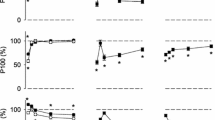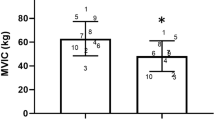Summary
A group of 5 women and 11 men walked on a treadmill, each carrying a weight in the right hand. In separate experiments, the mass was varied to give total exhaustion within 3 min, 5 min, 9 min, and 13 min. In additional experiments 50% and 25% of the masses leading to exhaustion after 5 min were used, and these were stopped after 16 min. Heart rate (f c) and systolic blood pressure (BPs) were measured noninvasively. There was a consistent increase in (f c) x BPs during the experiments leading to exhaustion, while steady-states were obtained in the nonexhausting trials. An electromyogram (EMG) was recorded with cutaneous electrodes over the flexor carpi ulnaris and flexor digitorum superficialis muscles and the number of zero crossings (ZC) of the EMG signal per time unit were analysed. As the subjects approached exhaustion, the number of ZC declined exponentially, reaching approximately 50% of their initial values. In the nonexhausting experiments, however, the decline was slower and less marked, and during the second half of the experiment the number of ZC increased again. Subjectively, endurance was underestimated by all the subjects. It was concluded that cardiovascular and muscle criteria of fatigue in carrying coincided. Prolonged carrying in one hand of more than 6 kg or 10 kg for young healthy women and men respectively should not be recommended, since it could lead to cardiovascular non steady-states and EMG signs of fatigue.
Similar content being viewed by others
References
Datta SR, Ramanathan NL (1971) Ergonomic comparison of seven modes of carrying loads on the horizontal plane. Ergonomics 14:269–278
DeLuca CJ, Sabbahi MA, Roy SH (1986) Median frequency of the myoelectric signal. Eur J Appl Physiol 55:457–464
Garg A, Chaffin D, Herrin GD (1978) Prediction of metabolic rates for manual materials handling. Am Ind Hyg Assoc J 39:661–674
Givoni B, Goldman RF (1971) Predicting metabolic energy cost. J Appl Physiol 30:429–433
Hagberg M (1981) On evaluation of local muscular load and fatigue by electromyography. Arbete och Hälsa no. 24, National Board of Occupational Health and Safety Solna, Sweden
Hägg G (1981) Electromyographic fatigue analysis based on the number of zero crossings. Pflügers Arch 391:78–80
Hägg GM, Suurküla J, Liew M (1987) A worksite method for shoulder muscle fatigue measurements using EMG test contractions and zero crossing technique. Ergonomics 30:1541–1551
Hägg GM (1991) Comparison of different estimators of electromyographic spectral shifts during work when applied on short test contractions. Med Biol Eng Comput 29:511–516
Hägg GM (1992) Recent contributions to the, interpretation of electromyographic spectral alterations and alteration indices at sustained contraction. J Appl Physiol (in press)
Jackson DH, Reeves TJ, Sheffield LT, Burdeshaw J (1973) Isometric effects on treadmill exercise response in healthy young men. Am J Cardiol 31:344–349
Kilbom Å, Persson J (1981a) Cardiovascular responses to combined dynamic and static exercise. Circ Res 48 [Suppl 1]: 93–97
Kilbom Å, Persson J (1981b) Circulatory response to static muscle contractions in three different muscle groups. Clin Physiol 1:215–225
Kilbom Å, Gamberale F, Persson J, Armwall G (1983) Physiological and psychological indices of fatigue during static contractions. Eur J App] Physiol 50:179–193
Lind AR, McNicol GW (1968) Cardiovascular responses to holding and carrying weights by hand and by shoulder harness. J Appl Physiol 25:261–267
Lindström L, Kadefors R, Petersen I (1977) An electromyographic index for localized muscle fatigue. J Appl Physiol 43:750–754
Malhotra MS, Sengupta J (1965) Carrying of school bags by children. Ergonomics 8:55–60
Merletti R, Sabbahi MA, De Luca CJ (1984) Median frequency of the myoelectric signal. Effects of muscle ischemia and cooling. Eur J Appl Physiol 52:258–265
Mital Å, Manivasagan I (1983) Subjective estimate of one-handed carrying tasks. Appl Ergon 14:265–269
Morrissey SJ, Liou YH (1984) Metabolic costs of load carriage with different container sizes. Ergonomics 27:847–853
Petrofsky JS, Burse RL, Lind AR (1975) Comparison of physiological responses of women and men to isometric exercise. J Appl Physiol 38:863–868
Rohmert W (1960) Ermittlung von Erholungspausen Mr statische Arbeit des Menschen. Int Angew Physiol 18:123–164
Roy SH, O'Hara JM, Brigand M (1990) Use of EMG spectral parameters to evaluate fatigue associated with pressure glove work. In: Anderson PA, Hobart DJ, Danoff JV (eds) Electromyographical Kinesiology, Exerpta Medica, International Congress Series 949, Elsevier Science Publishers, Amsterdam, pp 283–286
Snook SH (1978) The design of manual handling tasks. Ergonomics 21:963–985
Author information
Authors and Affiliations
Rights and permissions
About this article
Cite this article
Kilbom, Å., Hägg, G.M. & Käll, C. One-handed load carrying — Cardiovascular, muscular and subjective indices of endurance and fatigue. Europ. J. Appl. Physiol. 65, 52–58 (1992). https://doi.org/10.1007/BF01466274
Accepted:
Issue Date:
DOI: https://doi.org/10.1007/BF01466274




